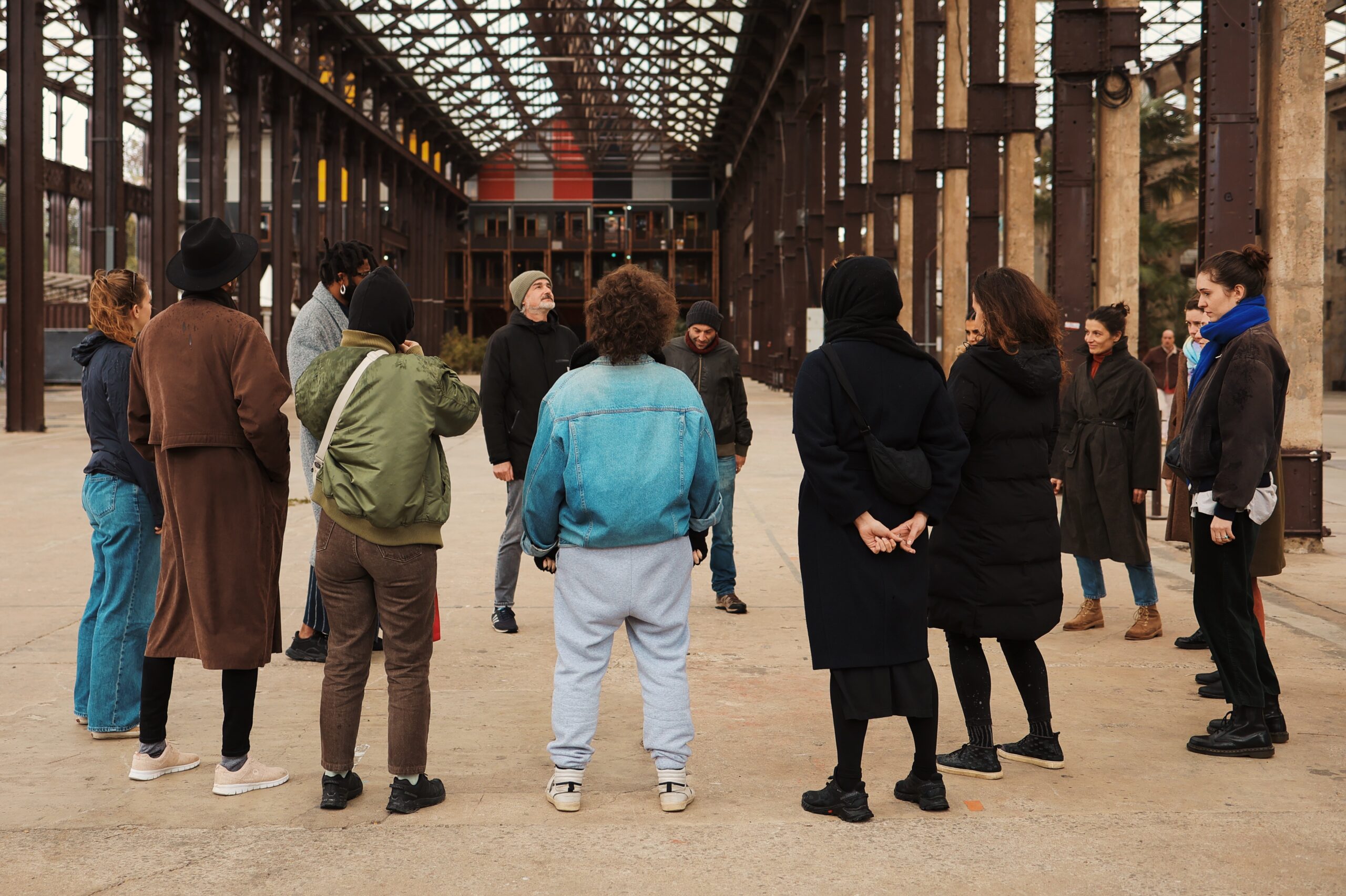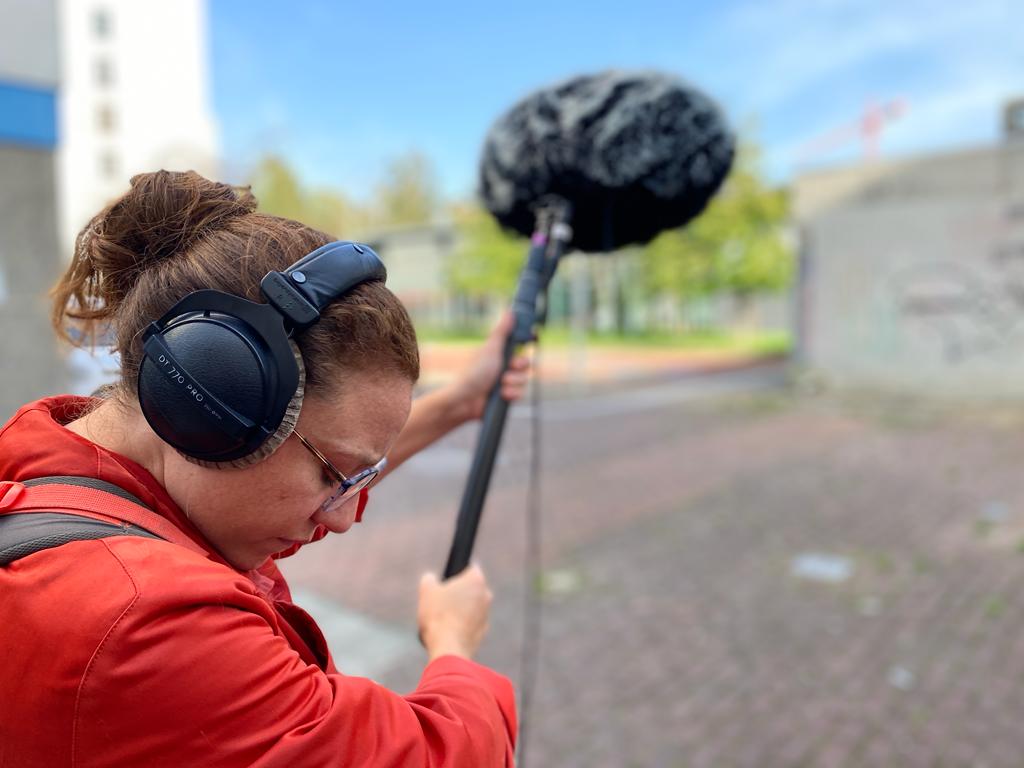How did you come to combine socio-urbanism and sound production?
I have a degree in urban planning and art philosophy, where I worked on documentary media, particularly comic books. Additionally, for several years, I developed voice and sound ambiance recording on a self-taught basis as part of my urban planning studies. I conducted research with Berlin residents who were fighting gentrification in central neighborhoods. The way I connect sociology, urban planning, and my artistic sound practice happened quite naturally.
In my work, I listen to inhabitants and their relationship to the territory—I do sensitive diagnostics—I record their words and their connection to places.
I create documentaries with the testimonies and soundscapes I compose with the voices, or in the form of naturalistic sound musical creations. I trained in Brussels, where I am currently making a documentary called “Attempt to Exhaust a Disappearing Place,” supported by ACSR (Atelier de Création Sonore et Radiophonique) and the Wallonia-Brussels Federation.
Can you tell us about your intervention during Slash Transition’s training program in Trempo?
It was about presenting my practice and offering sound artists – who are more focused on musical practice – what we call field recording. I proposed an outline of my experiences, starting with listening to my early sound objects: things not necessarily well edited or well recorded, to then listen to more accomplished sound creations, showing how to have an intention of realization, to choose certain angles in sound recording, and to work on interview techniques and the realization of a narration, with characters and places to make them sound together.
You mention "invisible publics" and position yourself in territorial transformation. Do you consider your work a form of political engagement?
Within my structure, Les Eclisses, there is, on one hand, a professionally committed stance, as I am part of a cultural urbanism movement advocating for artists to be integrated into public contracts related to land development.
On the other hand, there is a political commitment through the subjects and people I focus on, the “invisible.” Those who, in consultation or citizen participation, do not attend workshops or participate in these processes.
I associate long periods of field scouting with voice collection work to record not only the most militant and visible people but also those who usually do not speak out. That is the whole issue of Les Eclisses: to make all the voices of a territory resonate.

Can you introduce us to Les Eclisses? What role does the artistic dimension play?
Les Eclisses is a project that combines participatory urbanism and documentary arts within the framework of territorial transformation. We work with residents in consultation or socio-urban diagnostics: we provide advice, support for associative structures, municipalities, and social landlords to understand the residents’ uses in their living environment and project future uses.
So we have a dual role as social science practitioners and artists.
We use the artistic medium to document the process and also to give participants a trace of their involvement in the project. We are currently on a mission in Aubervilliers for a consultation on the outdoor spaces of a social housing residence, for which we conducted extensive investigation work and participatory workshops on-site and in sensitive mapping. We made recommendations in terms of urban programming and local development of the site’s associative life, and we created a documentary comic book with the residents on their uses, experiences, and projections in their living environment.
You use an original approach, at the crossroads of different worlds. Are there authors or works that inspire it?
One of my ongoing documentary works is called “Attempt to Exhaust a Disappearing Place,” and I am working on a method inspired by Georges Perec, who “exhausts” places, like the street of his childhood, destined to be demolished to build the Belleville park. He writes, he takes notes on what will soon be demolished and what will disappear, things that are not always directly accessible and require regular visits to be perceived.
In my practice, field recording and poetic description are used to study places very finely, to see what is not visible at first glance or first listen.
The neighborhood where I work in Brussels is called Les 5 Blocs and will soon be entirely demolished. Before its disappearance, I am talking with residents who have not been rehoused and still live in a nearly emptied neighborhood. In terms of sound documentary, I would also mention Kaye Mortley, a sound creation director who gives significant importance to sensitivity, to voice, but also to the soundscape.
To broaden and conclude, what role could sound play in urban planning development?
I advocate for sound ecology to move beyond the noise map, which consists of recording decibels and is the main tool used in planning. I propose active listening walks of the sound environment to allow a sensitive perception of the territory by the ear. We then invite participants to mark on a map the spaces to be preserved and prioritized and the too noisy or unpleasant spaces that tire the ear, proposing their own caption and symbols to signify their representations of places based on the listening they have done.
These active listening experiences also help to understand that we are not equal in sound perception. When women walk, they will be attentive to certain sounds, for example, because there is insecurity in the street at certain times. This state of vigilance is not necessarily the same as that of men; it thus enriches the reading of the territory. The active listening method reveals a practice of space and landscape that is not only visual but also sound and should, in my opinion, guide land development and urban fabric professionals.

Content & writing: Simon Grudet
Photos: Slash Transition training in Trempo, March 2024
©Margaux Martin’s
Links:
Trempo
Les Eclisses – Lucie Mesuret


